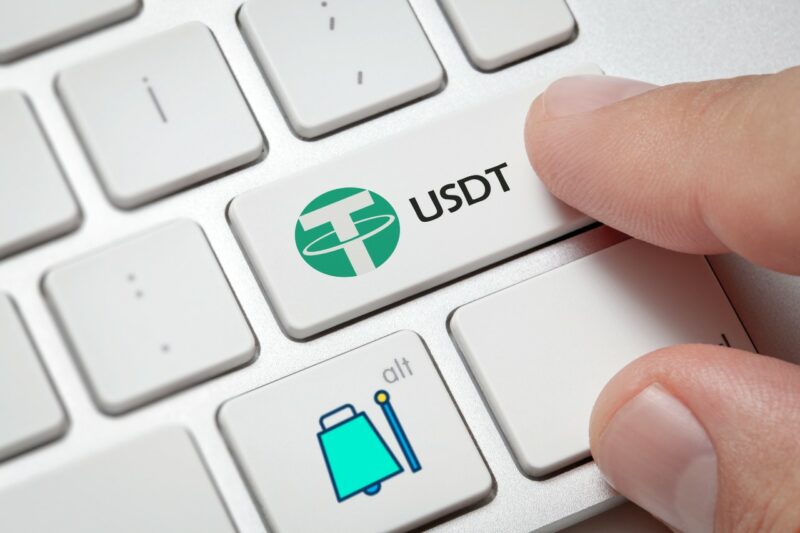
Tether FUD (Fear-Uncertainty-Doubt) continues, most recently with highly respected commentators such as Grant Williams weighing in and ascribing a high likelihood of the stablecoin being under-reserved and possibly fraudulent.
In this note we’re going to look at the claims and try to evaluate what effect it could have on our crypto investments it if it turned out that Tether was, in fact, a complete scam.
Tether is the first “stablecoin”, which is a digital currency that endeavours to maintain parity (a peg) with its counter-party instrument: the US dollar.
1 Tether (USDT) should equal $1 USD. There is constantly varying degrees of slippage around this (and any other stablecoin)
Tether is the third largest digital currency by market cap, at around $63B USD. Note also that I keep calling Tether “a digital currency” and not a crypto currency. This is because there is no Tether blockchain and USDT’s are not mined, they’re “minted”.
Ostensibly, Tether receives USD from depositors and then “mints” a corresponding amount of USDT and puts that into their depositors’ account.
This is where everything gets funky.
The depositor then takes that USDT on whatever ecosystem they’re in (these days mostly Ethereum or TRON) and begins moving it around to where they want it to be. They can buy Bitcoin with it. Or Ethereum. They can stake that USDT into myriad Decentralized Exchanges (DEX) platforms like Sushiswap, Aave, etc, or even stake it into more complex yield farms and liquidity pools like Yearn, Curve, Compound, et al.
And they can earn yield on that. More yield than can be earned out in the legacy world. 5%, 7%. With some of the more complex DeFi strategies you can get north of 10% and if you want to go full “degen” (short for “degenerate”) you can ostensibly bag APRs in the triple digits.
Contrary to Bitcoin or Ethereum, where we know the providence of every single unit, we don’t know anything about Tether.
Every BTC or ETH mined is accounted for and visible. Every single transaction they’ve ever been a party to is logged to a public blockchain that anybody can access. And it’s all executed using protocols laid out in open source software that anybody can download and read.
But nobody really knows for sure where these Tethers are coming from or what happens to the assets backing them from which they are ostensibly reserved. Nobody knows for sure if newly minted USDT have any backing at all.
For all we know, and what people like Crypto Anonymous, @Bitfinexed, Bennett Tomlin and George Noble are alleging, is that Tether just pulls this stuff out of thin air.
If Tether is just minting USTD out of thin air and then using it to buy up Bitcoin, Ethereum and any other assets they can, then that’s a problem (and it’s also an exact microcosm of what central banks have been doing with intensified zeal since 2008).
The original Crypto Anonymous article (linked above) plotted Tether issuance with the rise in the value of Bitcoin and it does look quite bang on
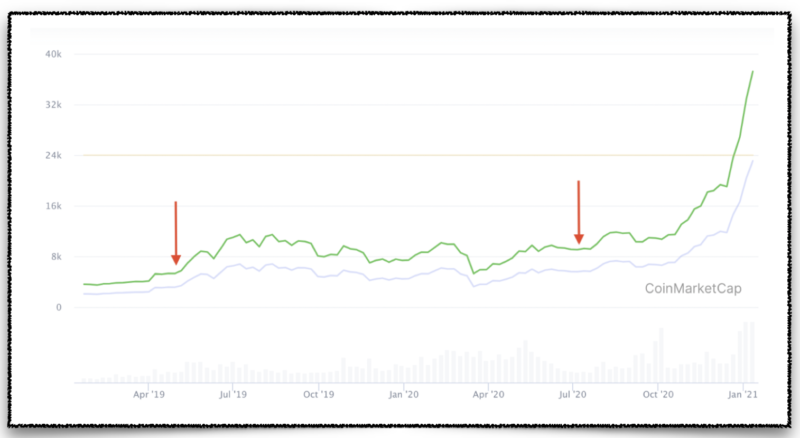
However it is worth noting some of the key moments in crypto as it plots against Tether’s market cap over the course of 2021 after the Bit Short came out.
Tether starts out the year with $21B USD market cap. By the time Bitcoin hits it’s all-time-high on April 14th, it’s more than doubled to $46B, while Bitcoin has also more than doubled, starting out the year at $30K USD and peaking on the eve of the Coinbase IPO a little north of $64K USD.
Then Bitcoin levels off and starts falling, while Tether issuance keeps right on going. What else keeps right on going over this same period?
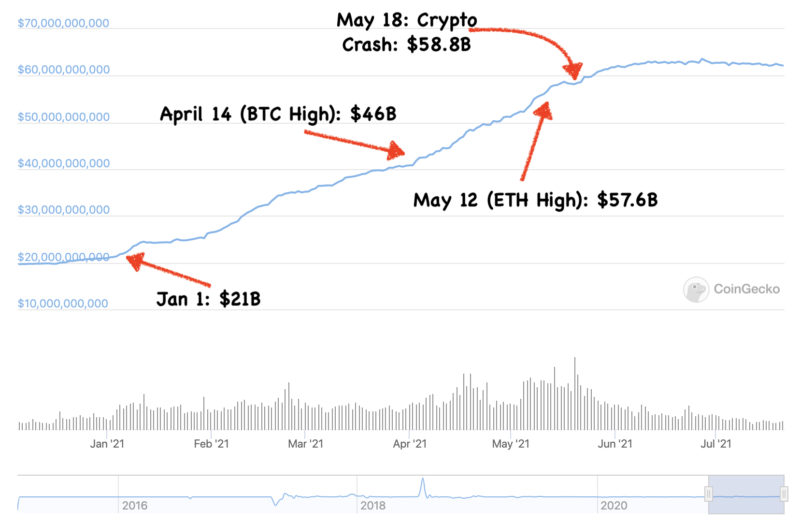
Ethereum. The price of ETH was $730 USD coming into 2021, by April 14 when BTC peaked it was at $2,436 USD. Ethereum itself peaks out on May 10 at $4,168 USD, and then crashes all the way down to $2,109 on the 22nd.
At this point, Tether issuance levels right off and has been flat ever since, while the cryptos have been trading down and sideways (although this may be in the process of ending, as we speak).
Tether continuing higher as Bitcoin enters a correction is a similar dynamic to what happened in 2018, after the cycle high in December 2017, as noted in the Schrödinger’s Coin note. This is the point when Tether’s banking relationships were being terminated, and so the thinking goes, USDT was never fully backed after that point (if it ever was). Tether issuance continued to climb higher while BTC entered a bear market.
Now, in today’s case, can $40B in Tether issuance, fraudulent or not be solely responsible for a half-trillion in market cap in the case of Bitcoin and another, call it $380 Billion in Ethereum over the course of the year?
Granted, the free-float for Bitcoin and Ethereum are smaller than the circulating supply, and I’ve seen estimates as low as 2 million for BTC. Could a net 34 Billion inflow of Tether generate a lift somewhere north of 60B worth of the increased price of BTC and some comparable lift in Ethereum?
The correlation is apparent. However could it also be plausible that Tether is running a similar market dynamic as cryptos in general? As enthusiasm and exuberance built over Q1 2021 did institutional depositors go into Tether more as did others into cryptos in general? Is Tether’s sideways motion it’s equivalent of a “bear market” which doesn’t manifest in a falling market cap because of that ostensible (albeit possibly fake) peg to the USD?
This is a separate question from whether it’s all a scam or not. Here we’re trying to tease out whether Tether is driving the crypto bull markets or a beneficiary of it.
From the Crypto Anonymous note:
“it still didn’t prove that Tether issuance was causing Bitcoin’s price increases. It was still possible that retail demand for Bitcoin was driving real USD into Tether Ltd. through some unknown mechanism; that Tether Ltd. was issuing Tethers in exchange for those dollars; and that those issued Tethers were then being used to buy Bitcoin. Under that scenario, Tether’s rise was being caused by Bitcoin’s demand, and Tether might be fully backed by dollars after all.”
This speaks to the two different questions. Where Crypto Anonymous seems to believe it’s either/or (Tether is fully backed and a beneficiary of the bull market, or it’s a fraud and driving it). But it seems possible to me that both could be true: Tether’s rise could be part of an overall crypto secular bull market and Tether could still be fraudulently padding their accounts by minting new, unbacked USDT. Perhaps aggressively so.
Grant williams enters the picture
Grant Williams was a co-founder of Real Vision who eventually parted ways with the company and it was taken over by Raoul Pal, the latter of which has gone “all in” on crypto. Williams, not so much.
Williams is a highly respected investment and finance commentator, who puts out a high signal, high quality premium letter called Things That Make You Go Hmmm to which I’m a subscriber. He does a fantastic podcast with Bill Fleckenstein called “The End Game”. Fleck and Williams are both crypto skeptics but I find it refreshing and useful to pay attention to well-reasoned skeptics. People who can put forth coherent arguments around why they don’t believe the crypto thesis, as opposed to shrill hysterics who are blinded by their own ideological biases.
The most recent newsletter edition titled Schrödinger’s Coin was a deep dive into the Tether phenomenon specifically. TTMYGH is behind a paywall, but he released this one publicly.
The note synthesizes the work done by Tether skeptics such as @Bitfinexed, Bennett Tomlin, George Nobel among others. The research these people have done on Tether, and its non-arm’s length “partner in crime” Bitfinex is formidable. From a smaller group of activists, I’d say it rivals the output, at least in terms of signal and quality, of the $TSLAQ collective (note that Williams is also a Tesla skeptic, as am I).
The problem, in a nutshell, and my own less intensive examinations around this arrive in the same place is that “Tether is a $60 Billion pile of liquidity that collateralizes a whole bunch of futures and leverage embedded in the crypto currency system”.
In the course of researching this, I’ve come to a slightly different conclusion that the case for Tether being a fraud may be essentially correct, and the ramifications of that culminating in a Tether Crisis would be significant and non-trivial, but they are not existential.
After the newsletter came out, Williams hosted a podcast with Bennett Tomlin and George Nobel to discuss. I came away from it persuaded that Tether could very well be a scam. I make little use of stablecoins but when I do I prefer Circle’s USDC instead, which is going public in the US soon and theoretically running a more transparent and regulatory kosher operation.
In the interview George Nobel used a “Bitcoin casino” analogy where participants used chips (Tethers) to go gamble in the crypto casino and then realize that when it comes time to cash out the value earned won at the gaming tables, the underlying chips themselves are worthless:
“Imagine we go to a casino, we go to Grant Williams’ casino and we want to play the game. So Bennet and I go to the Grant Williams casino and we go and buy a thousand dollars worth of chips. And then, we’d go play the games. We go play Bitcoin and Dogecoin and whatever coin. And at the end of the night, we have whatever we have. Let’s say we broke even. We have $1,000 worth of chips. And we go back to the window, and Mr. Williams is behind the window, and we say, “Can we please have our fiat back. Can we have our dollars back.” And they’re like, “Hmm, slight problem.” “What do you mean?” “Well, we don’t have the dollars.” And so then everyone on the casino floor realizes that they think they’ve got whatever, how many chips they have in their pockets, they think that’s real money. Well, turns out it’s not good for anything. So that’s really the simplest analogy I can give.”
That analogy is flawed because it assumes that the only egress out of the crypto casino is via the cashing out the worthless chips (Tether). But that isn’t the case at all. People wanting to convert the value held in Bitcoin or Ethereum into other instruments have a plethora of ways to do that – they can go into another crypto, some other stablecoin, or settle directly into cash on an exchange.
However, think about the following. Let’s pretend nobody is worried about Tether right now but that someday people become worried about another instrument that is seemingly printed at will out of thin air with no backing in increasing volumes. Let’s call that instrument a “dollar”.
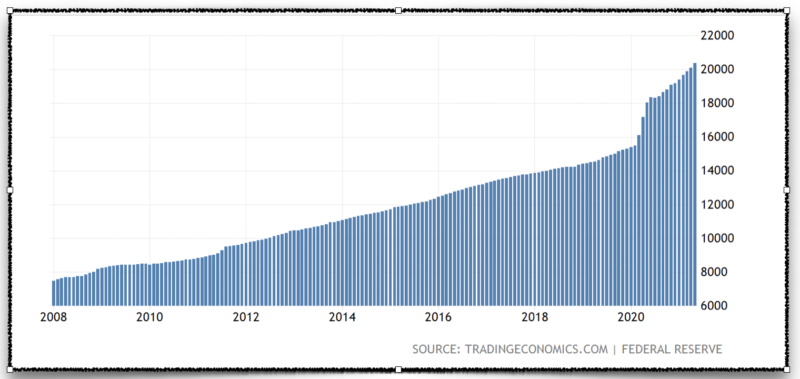
Now imagine people trying to convert their dollars into anything non-dollar by putting it into cryptos, real estate, the stock market and then one day (“gradually, then suddenly”) confidence in the dollar collapses entirely and it becomes close to worthless.
What happens to the value of the assets that everybody bought using those dollars while they still held any value?
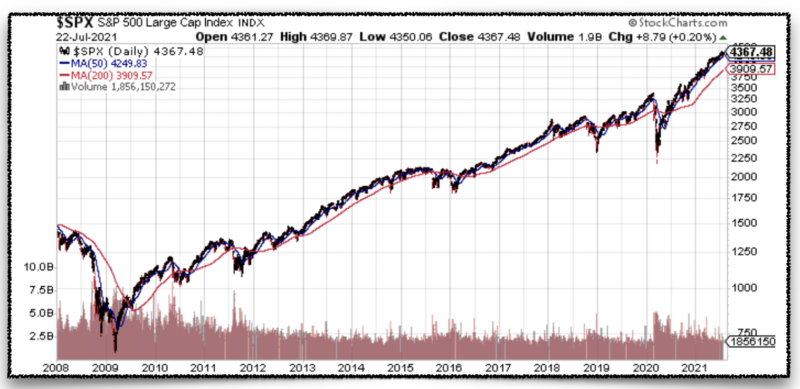
Will they also collapse to zero? No, in fact probably the opposite.
In the same conversation, Tomlin was talking about the idea promulgated by some that a collapse in Tether would actually raise the price of Bitcoin, as participants frantically attempted to dump Tether and move into something else:
“The people who say Bitcoin would go up as people try to get out of Tether might be partially right on the Tether exchanges. So what I would expect you would see in those cases is a huge premium open up between the price of Bitcoin on exchanges that primarily denominate in Tether, and the price of Bitcoin on exchanges that primarily nominate in US dollars. So on an exchange like Binance, where a lot of the pairs are against Tether, you might see people willing to trade absurd amounts of Tether for one Bitcoin, 10 million Tethers, 20 million Tethers, whatever, because everyone’s aware there is some risk of Tether.”
Tomlin is describing the dynamics of a hyperinflation, perhaps without intending to. Again, substitute the word “Tether” with “Dollar”, and what are we looking at? A currency collapse.
What if it’s true?
Now, what if all that said, Tether is a complete fraud, and intrinsically worthless. There’s no collateral there to hold the peg, it’s all been spent on villas and yachts. Then what?
Tether is now in excess of $60 Billion and at least some of it is being used as collateral in various staking, collaterization and liquidity pools.
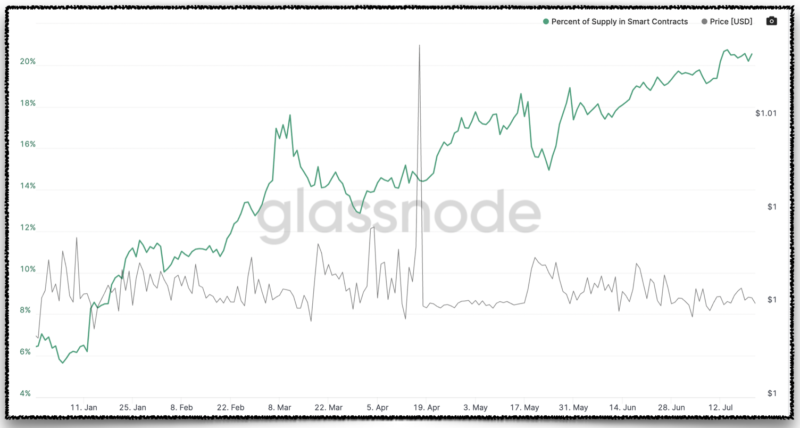
Right now there is $55 Billion Total Value Locked (TVL) into DeFi smart contracts on Ethereum, down from a record $90B back near the highs in May. While as much as 20% of Tether is locked in DeFi smart contracts on Ethereum, it’s estimated as much as 70% of Tether is sitting in centralized exchanges.
If a Tether Crisis occurs, it would set off a cascading failure of myriad DeFi applications as instruments collaterized in part by USDT would vapourize, causing a chain-reaction. An even larger liquidity shock would completely seize up the centralized exchanges, especially the ones with high levels of USTD reserves.
It would look like what happened across the entire space during the May crypto crash, except it might drag out for days or even weeks, if it turns out that Tether is more embedded into the crypto economy than most people thought.
However I think the ramifications of it being true that Tether could be a total zero are contrary to those who think it would mean the death knell for cryptos.
A Tether Crisis won’t kill cryptos. The crypto economy would take a hit, possibly a big one, and then it’s going to rebuild itself and keep moving forward. Ironically, that will all happen without any bailouts or regulatory interventions. Everyone involved is going to take full ownership for their own losses. Imagine that.
In the end I think what Tether shows us are the dangers of being able to print value ex-nihilo and be able to use that as collateral or even currency.
Bitcoin maxi’s say that Bitcoin derives its value from the economic tradeoff involved in the energy needed to mine it, Ethereum is the same for now but after it moves to proof-of-stake one could posit the value is derived from the community and the market inertia of the ecosystem.
Even printing a digital currency out of thin air at whim and with no supply cap would be fine (in the sense of legal) but probably close to worthless. See: Safemoon.
But “minting” a stablecoin that is claimed to be pegged to some other asset, without being adequately reserved against it, would be fraud.
What is interesting to note is that if Tether is a complete fraud and what they are doing is essentially counterfeiting a fake currency peg, pay attention to what exactly is being counterfeit: they’re not pretending to mint Bitcoin because they can’t. Nobody can, which is entirely the point of crypto currency.
They’re pretending to mint a peg to fiat dollars, which are themselves backed by nothing and can be created at will, and using it to buy what? Cryptos.
Said differently, Tether tells us more about the flaws inherent in fiat currencies than it does about cryptos. Tether could be viewed as a microcosmic example of the USD being played out in fast-forward. When and if Tether implodes, we should watch carefully for hints of what could happen in a full blown USD (or any other fiat currency) crisis.
If / when Tether implodes and goes to zero, we may face yet another body blow that over time, cryptos will surmount and recover from. How much and how long depends on where we are in the cycle.
We deal mainly with crypto stocks which generally track the market, but for our readers who hold cryptos directly, we’ll review the defensive posturing so that we never get mangled in a liquidity crisis:
-
- Don’t trade on margin (neither cryptos nor stocks)
- Never leave your coins on an exchange.
- Aside from speculative YOLO funds, avoid complex DeFi strategies that collaterize or rehypothecate your assets
- Don’t hold any value in Tether. If you have to trade into USDT to get out of some exotic or thinly traded alt coin pair, immediately get out of it and move to some other asset.
- If you have to make use of a stablecoin, use USDC or DAI.
- I would specifically avoid Bitfinex and, Binance for different reasons, noting that Binance is also having regulatory issues in multiple jurisdictions
- When using exchanges, use a known exchange in your own country. This is how I prefer it so (God forbid) should the exchange implode you are at least on home turf for any legal proceedings.
What many crypto skeptics fail to appreciate is that increasingly more funds flowing into the crypto economy are intentionally on a one-way trip. They are going there with the intention of never being converted back into fiat. I see all of these weak points we just enumerated as indicative of the fiat world we are cashing out of of, not the crypto world we’re moving into.
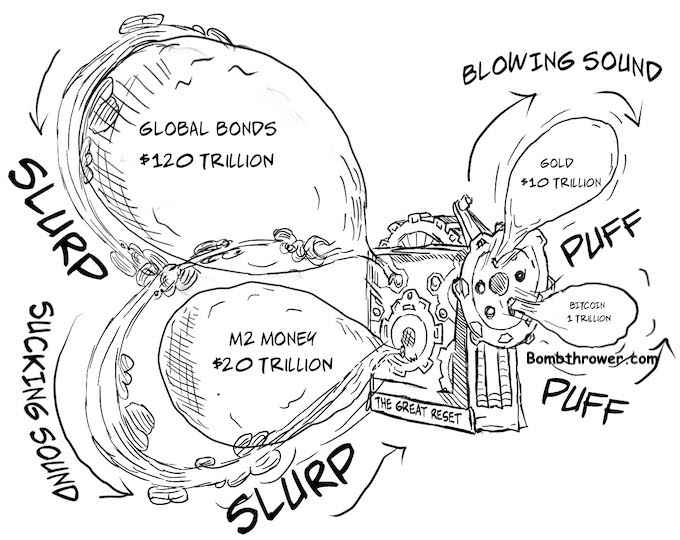
When I really think about the effect a Tether implosion would have on cryptos, I suspect it will mostly depend on whether cryptos overall are already in a bullish or bearish cycle at the time it happens.
That is the nature of crypto, and markets in general. You can tell you’re in a bear/sideways correction when good news doesn’t do anything for the asset, and you can tell that you’re in a bull move when bad news is shrugged off.
Either way, the societal shift into crypto continues apace.
(This post was an excerpt from the premium version of The Crypto Capitalist Letter, which covers the global, revolutionary shift into the crypto economy with a tactical focus on garnering exposure via publicly traded crypto stocks. You can get a copy of the The Crypto Capitalist Investment Thesis for free when you subscribe to the Bombthrower mailing list, or cut straight to our trial offer of The Crypto Capitalist Letter).


I'm in England and held various coins paired with Tether on Binance. As the market was going nowhere and I read about Binance having regulatory issues, I decided to move all my assets back to fiat. I got as far as GBP, but Binance wouldn't allow transfer to the bank account I used when I started in Binance nor the debit or credit cards attached to the account. Their message said something like, '' this transfer isn't supported'' and' 'disabled for maintenance' '.
I know nothing about computers or tech and never had a wallet, just left my funds in coins on Binance.
Eventually, I found a YouTube video that knew the problem and had a workaround. I was told to get a wallet on something called Mode. Convert the GBP on Binance to BTC, then send it to Mode. It worked, though Binance took a long time to finally let go of my money.
From Mode, I moved a small amount to my bank and it credited the transfer almost instantly, so I know Mode is real, a big relief. I decided to leave the rest on Mode in BTC as bitcoin is going up again.
I would never go back to Binance!
Can anyone recommend where to buy and sell coins.?
Mark, you said don't leave your funds on an exchange, where should I hold them? Keep it simple please, I'm really not good on the tech terms or uses.
Thanks
Steven
I watched you at Warroom talking about the debt ceiling in US and the devaluation of the dollar. You said something about cripto currency. On these days, it is difficult to trust online information, but I trust Banon and being you his guest in his program I want to ask you about it. I want to protect my savings and want to learn more about it. Can you recommend me a site? Thanks